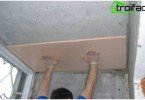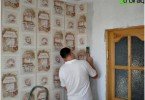Currently, there is a huge amount of finishing materials for walls, ranging from the simplest and most affordable, ending with the elite and very expensive. However, for many years now, wallpaper has been a classic in decorating the walls of a living room. Their diversity creates certain difficulties. That is why, when deciding on how to choose a wallpaper, it is necessary to clearly know their main types, advantages, disadvantages and operational characteristics.
Content
- Classifications of modern wallpapers
- Well-known paper material
- Resistant Vinyl Wallpaper
- Non-woven wallpaper – base for painting
- Fiberglass options
Classifications of modern wallpapers
The market for decoration materials abounds with wallpapers for every taste and budget. That is why it is impossible to give a complete classification of wallpapers, but it is quite realistic to single out the main criteria by which they are divided into types.
Depending on the degree of moisture resistance, they are divided into:
- Ordinary wallpapers that do not require any cleaning except dry, since they do not have a moisture-resistant coating.
- Moisture resistant wallpaper. Small contaminated areas can be wiped with a slightly damp sponge or cloth. Do not use detergents or cleaning products..
- Washable wallpaper. This type of finishing materials is quite capable of withstanding wet cleaning with household detergents..
- Superwashable wallpapers are extremely resistant even to frequent wet care. In addition to a soft cloth or sponge, you can even use a brush.
The appearance of the wallpaper is also a criterion for their classification. So, the wallpaper is divided into:
- Smooth.
- Embossed. Even in the production process, a relief pattern is applied to the surface of the wallpaper. Such wallpaper can be embossed or corrugated..
- Imitating the texture of a material. Externally, such wallpaper may not differ from brickwork, plaster or any other decorative material..
Undoubtedly, all wallpapers vary in density. It is customary to highlight:
- Lightweight wallpapers weighing less than 110 g / m2.
- Heavy wallpaper. Most often, such a finishing material is multilayered, which ensures its weight from 110 g / m2 or more.
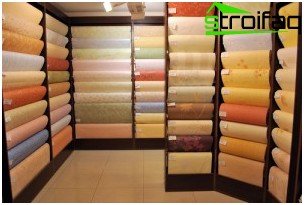
The variety of types of wallpaper
Obviously, these classifications are rather arbitrary, since every year new types of wallpaper appear on the market of finishing materials.
Today, wallpapers are roll-up finishing material with a different base, on which this or that decorative coating is applied. This material is applied to the walls using special wallpaper glue. Thus, the most reasonable classification of wallpaper depending on the manufacturing technology and basis.
In this case, all wallpapers can be divided into the following groups:
- paper;
- vinyl;
- wallpaper for painting;
- cullet.
Well-known paper material
When deciding which wallpaper to choose, first of all we recall the classic paper wallpaper. It is customary to single out single-layer and two-layer paper wallpapers. The first ones are quite simple – this is a layer of paper with a pattern printed on it. Two-layer analogues differ in that the first layer is the basis, and the second layer is a decorative coating on which the drawing is applied.
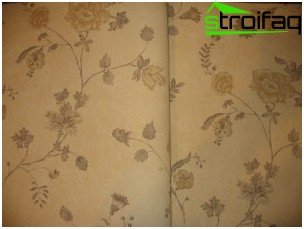
Wall paper for wall decoration
Obviously, paper wallpapers are a fairly economical option, as they have many disadvantages. They do not differ in strength, easily fade when exposed to sunlight, they can not be subjected to wet cleaning. In addition, when paper-coated with paper, all the irregularities of the walls and their defects become noticeable to the naked eye.
However, paper wallpaper is ideal if there are young children in the house who love to draw. Spoiled finishing material will not be a pity to replace in the near future, which will not entail large financial costs.
Resistant Vinyl Wallpaper
This type of wallpaper is distinguished by the presence of two layers – the base and the decorative layer on which the drawing is applied. A feature of such a material is that strong paper or fabric is used for the base. In the latter case, wallpaper is usually called textile. The top layer is a polyvinyl chloride film.
Vinyl wallpapers are characterized by excellent performance: they are strong enough, resistant to various mechanical damage, easy to wet cleaning, environmentally friendly and durable.
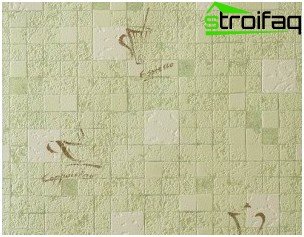
Wall decoration with vinyl wallpaper
The variety of decorative coatings for vinyl wallpapers allows you to create the necessary visual effects in the room and set the desired accents.
However, when purchasing vinyl wallpapers, it is worth remembering that they are airtight. After pasting with them, the walls do not “breathe”, so the room will have to regularly monitor the level of humidity.
Non-woven wallpaper – base for painting
So, how to choose wallpaper for the walls that are supposed to be painted? For this, a finishing material based on a non-woven layer is ideal. Non-woven wallpaper is durable and has good sound insulation and no unwanted stretch marks when pulling on the wall.
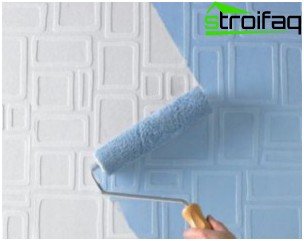
Wallpaper for painting on a non-woven basis
This type of wallpaper is perfect for painting walls for the reason that they hide even fairly large flaws, which is difficult to achieve when applying paint directly to the wall surface. In addition, non-woven wallpaper requires multiple staining, which is extremely convenient, since there is no need to remove the old paint layer from the wall surface.
Solving the problem of how to choose wallpaper for painting, you can opt for non-woven wallpaper for another reason. The fact is that they already have an adhesive layer, which allows you to apply glue only on the surface of the wall. In addition, this type of finishing material is easily removed from the wall if necessary..
Fiberglass Wallpaper
At the heart of this finishing material are fiberglass threads. Cullets can have one or two layers, in addition, their surface can also be different – smooth or corrugated.
For the manufacture of this type of wallpaper, only environmentally friendly raw materials are used, which makes them absolutely safe during operation. Having chosen fiberglass, you don’t have to worry about the appearance and reproduction of various microorganisms in them, since there is simply no nutrient medium for them.
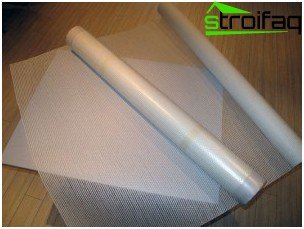
Fiberglass Wallpaper
Cullets are distinguished by excellent characteristics: they are durable, durable, practically do not break. It is worth noting that after decals on the walls they need to be painted with acrylic or water based paints. Finished coating can serve for years, but in residential premises they are rarely used. Most often as an original element of decor in any part of the wall.
How to choose wallpaper for different rooms?
The problem of how to choose the right wallpaper for a room, sooner or later confronts any person. Obviously, there are some nuances, the accounting of which allows you to choose the finishing material as efficiently as possible..
All rooms in the living room are distinguished by the degree of functionality and purpose, therefore, wallpapers for them are selected different.
How to paste over the living room
In this room it is customary to gather as a family and meet guests. The functional load of the living room is extremely high, so it is worth paying special attention to the issue of choosing a wallpaper for it. So, they must meet the style decision of the room. If it is eco-style, then the wallpaper should be chosen from natural materials. The best option would be textile wallpaper.
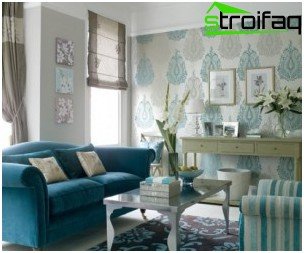
Wallpaper for the living room
Wallpaper for the living room should be easy to clean and have a high degree of strength. It is worth considering the degree of illumination of the room. Do not get dark wallpaper for a living room with poor natural light or heavy curtains.
How to decorate the walls in the bedroom
In the bedroom, it is definitely necessary to create an atmosphere of peace and comfort. Wallpaper plays an important role in this. Most often, for the bedroom, wallpapers of light and muted tones are selected. It is possible to use wallpaper with a small pattern, but if there is a large space, you can safely choose a wallpaper with large, but not elaborate images.
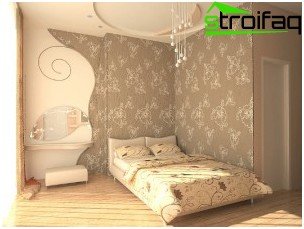
Textile wallpaper for the bedroom
The best choice for the hallway
Hallway – this is the part of the living room where the likelihood of contamination of finishing materials is maximum. That is why the wallpaper for the hallway must be moisture resistant, so that they can easily be subjected to thorough wet cleaning, and durable.
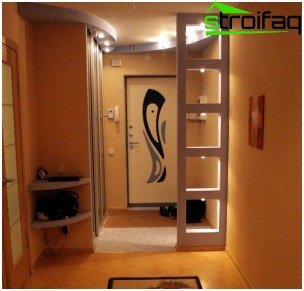
Finishing the hallway with wallpaper
In addition, wallpapers for the hallway most often choose dark shades. The reason is the same – a large accumulation of dust and dirt. However, it is worth in this case to provide a sufficient number of artificial lighting sources in the hallway. The fact is that dark wallpaper will give the hallway gloom and visually narrow it.
Wallpaper for walls in the nursery
The children’s psyche is very mobile and susceptible, therefore, the question of how to choose wallpaper for this room should be carefully considered. Currently, there are a huge number of children’s wallpapers with images of your favorite cartoon and fairy-tale characters. The color of the wallpaper should not be too bright. In such a room, it will be difficult for the child to concentrate, he will be irritable and tearful. However, the final choice of wallpaper will depend on the temperament of the child.
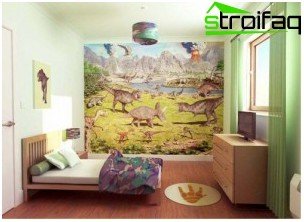
Decorating a kids room with wallpaper
What to look for when buying wallpaper?
Having decided what kind of wallpaper is needed for this or that room, we go to the store. At this stage, experts recommend paying attention to a number of nuances. In particular, choosing a wallpaper, it is necessary to take into account the fact that the lighting in the trading floor is different from the lighting in the living room. This means that the shade of the wallpaper may subsequently vary slightly..
In addition, when buying a sufficiently large number of rolls, you need to check that their lot number is the same. Differences in batch number may result in wallpapers of different colors being pasted on one wall.
Each roll of wallpaper has a marking that contains information about the operational characteristics of this type of finishing material. Do not be shy about consulting the seller about unfamiliar and incomprehensible icons on this label. This will avoid many undesirable consequences of the purchase..
Thus, the choice of wallpaper for a living room is a fairly responsible process. A competent approach to which will make any room cozy and comfortable.


